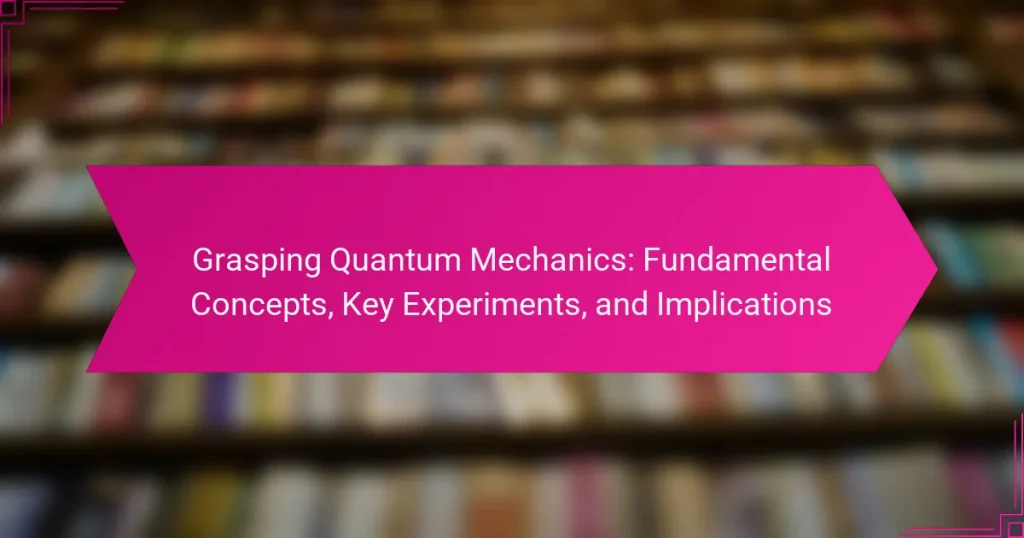Quantum mechanics is a fundamental theory in physics that describes the behavior of matter and energy at atomic and subatomic levels. This article explores key concepts such as wave-particle duality and quantum entanglement, highlighting significant experiments like the double-slit experiment, the photoelectric effect, and Bell’s theorem. The implications of quantum mechanics extend across various fields, influencing advancements in technology, chemistry, biology, and medicine, while also raising philosophical questions about determinism and reality. Understanding these foundational aspects is crucial for grasping the impact of quantum mechanics on modern science and technology.

What is Quantum Mechanics?
Quantum mechanics is a fundamental theory in physics that describes the behavior of matter and energy at the smallest scales. It explains phenomena that classical physics cannot, such as wave-particle duality and quantum entanglement. Quantum mechanics is essential for understanding atomic and subatomic particles. It forms the basis for technologies like semiconductors and quantum computing. The theory emerged in the early 20th century, with key contributions from scientists like Max Planck and Albert Einstein. Experimental evidence, such as the double-slit experiment, validates its principles. Quantum mechanics fundamentally alters our understanding of reality, challenging classical intuitions about determinism and locality.
How does Quantum Mechanics differ from classical physics?
Quantum mechanics differs from classical physics primarily in its treatment of particles and waves. Classical physics describes particles as having definite positions and velocities. In contrast, quantum mechanics introduces the concept of wave-particle duality. This means particles can exhibit properties of both waves and particles.
Additionally, quantum mechanics incorporates the principle of superposition. This principle allows particles to exist in multiple states simultaneously until measured. Classical physics does not account for this behavior.
Moreover, quantum mechanics introduces the uncertainty principle, formulated by Werner Heisenberg. This principle asserts that certain pairs of properties, like position and momentum, cannot be simultaneously known with arbitrary precision. Classical physics assumes that all properties can be measured without limitation.
Quantum entanglement is another key difference. In this phenomenon, particles become linked and the state of one can instantaneously affect the state of another, regardless of distance. Classical physics does not accommodate such non-local interactions.
These distinctions highlight the fundamental differences in how quantum mechanics and classical physics explain the behavior of matter and energy.
What are the fundamental principles of Quantum Mechanics?
The fundamental principles of Quantum Mechanics include wave-particle duality, uncertainty principle, superposition, and entanglement. Wave-particle duality states that particles exhibit both wave and particle characteristics. This principle is exemplified by the double-slit experiment, which shows interference patterns indicative of wave behavior. The uncertainty principle, formulated by Werner Heisenberg, asserts that certain pairs of physical properties cannot be simultaneously known with arbitrary precision. For instance, the position and momentum of a particle cannot be precisely measured at the same time. Superposition allows particles to exist in multiple states simultaneously until measured. This is illustrated by Schrödinger’s cat thought experiment. Entanglement describes a phenomenon where particles become interlinked, such that the state of one instantly influences the state of another, regardless of distance. These principles form the foundation of Quantum Mechanics, influencing modern physics and technology.
Why is uncertainty a key concept in Quantum Mechanics?
Uncertainty is a key concept in Quantum Mechanics due to the Heisenberg Uncertainty Principle. This principle states that certain pairs of physical properties, like position and momentum, cannot be simultaneously known with arbitrary precision. As a result, the more accurately one property is measured, the less accurately the other can be determined. This inherent limitation is not due to measurement errors but is a fundamental property of quantum systems. It reflects the wave-particle duality of particles, where particles exhibit both wave-like and particle-like behavior. Experiments, such as those involving electrons, consistently demonstrate this uncertainty in measurements. The principle has profound implications for our understanding of reality at the quantum level, challenging classical notions of determinism.
What are the foundational concepts of Quantum Mechanics?
The foundational concepts of Quantum Mechanics include wave-particle duality, superposition, entanglement, and uncertainty principle. Wave-particle duality describes how particles exhibit both wave-like and particle-like properties. Superposition states that particles can exist in multiple states simultaneously until measured. Entanglement refers to the phenomenon where particles become interconnected, affecting each other’s states regardless of distance. The uncertainty principle, formulated by Heisenberg, asserts that certain pairs of physical properties cannot be simultaneously known with arbitrary precision. These concepts are supported by numerous experiments, including the double-slit experiment, which demonstrates wave-particle duality, and Bell’s theorem, which provides evidence for entanglement.
What is wave-particle duality?
Wave-particle duality is a fundamental concept in quantum mechanics. It describes the dual nature of matter and light. Specifically, entities like electrons and photons exhibit both wave-like and particle-like properties. For example, light can behave as a wave, demonstrating interference patterns. Conversely, it can also act as a particle, as shown in the photoelectric effect. This duality was notably illustrated in experiments such as the double-slit experiment. In this experiment, particles create an interference pattern when not observed, indicating wave behavior. When observed, they behave like discrete particles. Wave-particle duality challenges classical physics, emphasizing the complexities of quantum behavior.
How does superposition work in Quantum Mechanics?
Superposition in quantum mechanics refers to a system’s ability to exist in multiple states simultaneously. This principle is foundational to quantum theory. When a quantum particle, like an electron, is measured, it collapses into one of its possible states. Before measurement, it can be in a combination of states, represented mathematically as a wave function.
The wave function describes the probabilities of finding the particle in various states. For example, an electron can spin both up and down at the same time until observed. This phenomenon was famously illustrated in the double-slit experiment, where particles create an interference pattern indicative of superposition.
Superposition challenges classical intuitions about reality. It suggests that particles do not have definite properties until measured. This principle is essential for technologies like quantum computing, where qubits leverage superposition to perform complex calculations.
Why is Quantum Mechanics important in modern science?
Quantum mechanics is important in modern science because it fundamentally describes the behavior of matter and energy at the smallest scales. It explains phenomena that classical physics cannot, such as wave-particle duality and quantum entanglement. Quantum mechanics underpins technologies like semiconductors and lasers, which are essential in electronics and telecommunications. The theory has led to advancements in medical imaging techniques, such as MRI. Quantum mechanics also plays a critical role in the development of quantum computing, which promises to revolutionize information processing. Overall, its principles are essential for understanding the physical universe and driving innovation across multiple scientific fields.
How has Quantum Mechanics influenced technology?
Quantum mechanics has significantly influenced technology in various fields. It is the foundation of modern electronics, enabling the development of semiconductors. These semiconductors are crucial for devices like smartphones and computers. Quantum mechanics also underpins the functioning of lasers, which are used in everything from barcode scanners to fiber-optic communication.
Additionally, quantum mechanics has led to advancements in medical imaging technologies, such as MRI machines. These machines rely on quantum principles to produce detailed images of the human body. Furthermore, quantum computing is an emerging field that promises to revolutionize data processing and encryption.
In summary, quantum mechanics has driven technological progress in electronics, telecommunications, medical imaging, and computing.
What are the implications of Quantum Mechanics for our understanding of the universe?
Quantum Mechanics fundamentally alters our understanding of the universe. It introduces concepts such as wave-particle duality and superposition. These principles challenge classical notions of determinism and locality. Quantum entanglement suggests that particles can be interconnected across vast distances. This phenomenon implies that information can be shared instantaneously, defying traditional communication limits. The uncertainty principle indicates inherent limitations in measuring certain pairs of properties, like position and momentum. This leads to a probabilistic view of reality rather than a deterministic one. Quantum Mechanics has also paved the way for advancements in technology, such as quantum computing and cryptography. These implications reshape our comprehension of matter, energy, and the fundamental structure of reality.

What are the key experiments in Quantum Mechanics?
Key experiments in Quantum Mechanics include the double-slit experiment, the photoelectric effect, and Bell’s theorem. The double-slit experiment demonstrates wave-particle duality. It shows that particles like electrons can display both wave-like and particle-like behavior depending on observation. The photoelectric effect, observed by Albert Einstein, proved that light can behave as both a wave and a particle. This phenomenon confirmed the quantization of light and earned Einstein the Nobel Prize in 1921. Bell’s theorem tests the concept of entanglement. It shows that particles can be correlated in ways that classical physics cannot explain, supporting the non-locality of quantum mechanics. Each of these experiments has significantly contributed to the foundational understanding of quantum theory.
What is the double-slit experiment and what does it demonstrate?
The double-slit experiment is a fundamental demonstration in quantum mechanics. It involves shooting particles, such as electrons or photons, through two closely spaced slits. When both slits are open, an interference pattern emerges on a screen, indicating wave-like behavior. This pattern suggests that particles can exist in multiple states simultaneously. When observed, however, particles behave like individual particles, not waves. This phenomenon illustrates the principle of wave-particle duality. It also highlights the role of observation in determining the state of a quantum system. The experiment challenges classical intuitions about reality and has significant implications for the understanding of quantum mechanics.
How does the double-slit experiment illustrate wave-particle duality?
The double-slit experiment illustrates wave-particle duality by demonstrating that particles can exhibit both wave-like and particle-like behavior. When particles, such as electrons, pass through two closely spaced slits, they create an interference pattern on a detection screen. This pattern indicates wave behavior, as waves from each slit overlap and interfere. However, when particles are observed or measured, they behave like discrete particles, hitting the screen at specific points. This duality shows that the fundamental nature of particles is not strictly wave or particle but a combination of both, depending on the experimental conditions. The experiment was first performed by Thomas Young in 1801, providing crucial evidence for the wave theory of light. Later, similar results were observed with electrons, reinforcing the concept of wave-particle duality in quantum mechanics.
What conclusions can be drawn from the results of the double-slit experiment?
The double-slit experiment concludes that light and matter exhibit both wave-like and particle-like behavior. When not observed, particles create an interference pattern, indicating wave properties. However, when measured, they behave as discrete particles, collapsing the wave function. This phenomenon demonstrates the principle of quantum superposition. The results challenge classical intuitions about reality. They suggest that observation affects the behavior of quantum entities. This experiment is foundational in quantum mechanics, illustrating the duality of nature.
What role did the Stern-Gerlach experiment play in Quantum Mechanics?
The Stern-Gerlach experiment demonstrated the quantization of angular momentum in quantum mechanics. It provided evidence for the existence of discrete quantum states. In the experiment, silver atoms were passed through a non-uniform magnetic field. The atoms were deflected in specific directions, indicating quantized spin states. This result contradicted classical physics, which predicted a continuous distribution of deflections. The experiment confirmed the concept of spin as an intrinsic property of particles. It also laid the groundwork for the development of quantum theory and the understanding of quantum superposition. The findings influenced later theories, including quantum information and quantum computing.
What did the Stern-Gerlach experiment reveal about quantum states?
The Stern-Gerlach experiment revealed that quantum states are quantized and exhibit discrete values. It demonstrated that particles, such as electrons, possess intrinsic angular momentum or spin. When passed through a non-uniform magnetic field, particles split into distinct paths. This splitting indicates that spin can only take certain values, such as up or down. The results confirmed the non-classical nature of quantum mechanics. The experiment provided evidence for the concept of superposition in quantum states. It showed that before measurement, particles exist in a combination of all possible states. This foundational experiment has significant implications for quantum theory and quantum computing.
How does this experiment contribute to our understanding of quantum measurement?
This experiment enhances our understanding of quantum measurement by demonstrating the concept of wave function collapse. It illustrates how measurement affects quantum systems, transitioning them from superposition to definite states. The experiment provides empirical evidence supporting the theory that observation influences quantum behavior. For instance, the double-slit experiment shows that particles behave differently when observed, indicating the role of the observer in measurement. This finding aligns with the Copenhagen interpretation of quantum mechanics, which asserts that measurement is fundamental to determining physical properties. Overall, the experiment deepens our comprehension of the interplay between measurement and quantum states, reinforcing critical theoretical frameworks in quantum mechanics.
What are other significant experiments that shaped Quantum Mechanics?
The double-slit experiment is a significant experiment that shaped Quantum Mechanics. It demonstrated the wave-particle duality of light and matter. When particles pass through two slits, they create an interference pattern. This pattern suggests that particles behave like waves. The experiment was first conducted by Thomas Young in 1801. It challenged classical physics and introduced the concept of superposition. Another key experiment is the Stern-Gerlach experiment. This experiment showed that particles have quantized angular momentum. It revealed the concept of spin in quantum particles. The Bell’s theorem experiments tested the phenomenon of entanglement. These experiments confirmed that entangled particles exhibit correlations regardless of distance. Each of these experiments contributed to the foundational understanding of Quantum Mechanics.
What insights did the Einstein-Podolsky-Rosen (EPR) paradox provide?
The Einstein-Podolsky-Rosen (EPR) paradox provided critical insights into the nature of quantum entanglement and the completeness of quantum mechanics. It challenged the notion of local realism, suggesting that particles can instantaneously affect each other regardless of distance. This phenomenon implies a deeper connection between entangled particles than classical physics allows. EPR argued that if quantum mechanics were complete, it would necessitate “spooky action at a distance.” Their work highlighted fundamental questions about measurement and the observer’s role in quantum systems. This paradox stimulated further research, leading to experiments confirming quantum entanglement, thus reinforcing the non-locality of quantum mechanics.
How did Bell’s theorem change the perception of quantum entanglement?
Bell’s theorem fundamentally altered the perception of quantum entanglement by demonstrating that entangled particles exhibit correlations that cannot be explained by classical physics. Prior to Bell’s theorem, entanglement was often viewed skeptically, as it suggested “spooky action at a distance.” Bell’s theorem provided a mathematical framework to test the predictions of quantum mechanics against local hidden variable theories. The theorem showed that if quantum mechanics is correct, then the results of measurements on entangled particles would violate certain inequalities, known as Bell inequalities. Experimental tests, such as those conducted by Alain Aspect in the 1980s, confirmed these predictions, supporting the non-locality of quantum mechanics. This shift led to a broader acceptance of quantum entanglement as a fundamental feature of reality, influencing both theoretical research and practical applications in quantum information science.

What are the implications of Quantum Mechanics in various fields?
Quantum mechanics has profound implications across various fields. In physics, it underpins the understanding of atomic and subatomic particles. This leads to advancements in technology, such as semiconductors and quantum computing. In chemistry, quantum mechanics explains molecular bonding and reactions, enhancing material science. In biology, it influences the understanding of processes like photosynthesis and enzyme activity. In philosophy, it raises questions about determinism and reality. In medicine, quantum mechanics contributes to imaging techniques like MRI. These implications demonstrate the versatility and foundational importance of quantum mechanics in modern science and technology.
How does Quantum Mechanics impact technology and innovation?
Quantum mechanics significantly impacts technology and innovation by enabling advancements in various fields. It underpins the development of semiconductors, which are essential for modern electronics. Quantum mechanics also facilitates the creation of quantum computers, promising exponentially faster processing capabilities. Technologies like MRI machines in medicine rely on quantum principles for imaging. Additionally, quantum mechanics influences cryptography, leading to secure communication methods through quantum key distribution. These innovations demonstrate how quantum mechanics drives progress in computing, healthcare, and security.
What are quantum computers and how do they leverage quantum principles?
Quantum computers are advanced computing systems that utilize the principles of quantum mechanics. They operate using quantum bits, or qubits, which can exist in multiple states simultaneously. This capability allows quantum computers to perform complex calculations much faster than classical computers. Quantum superposition enables qubits to represent both 0 and 1 at the same time. Quantum entanglement allows qubits to be interconnected, enhancing computational power. These principles enable quantum computers to solve specific problems, like factoring large numbers, more efficiently. Research indicates that quantum computers can outperform classical counterparts in certain tasks, demonstrating their potential in fields such as cryptography and optimization.
How is Quantum Mechanics applied in cryptography?
Quantum mechanics is applied in cryptography through techniques like quantum key distribution (QKD). QKD uses the principles of quantum mechanics to securely exchange encryption keys. It relies on quantum states of particles, such as photons, to transmit information. Any attempt to eavesdrop on the key exchange alters the quantum states. This alteration alerts the communicating parties to potential security breaches. Notable protocols include BB84 and E91, which demonstrate secure key distribution. Research shows that QKD can achieve unconditional security based on the laws of physics. Thus, quantum mechanics fundamentally enhances the security of cryptographic systems.
What philosophical questions arise from Quantum Mechanics?
Quantum Mechanics raises several philosophical questions. One major question concerns the nature of reality. Are particles real when not observed? This is linked to the observer effect. Another question addresses determinism versus indeterminism. Does Quantum Mechanics imply that events are fundamentally random? Additionally, the concept of superposition challenges classical notions of existence. Can something be in multiple states simultaneously?
The nature of time also comes into question. Is time an illusion at the quantum level? Furthermore, the role of consciousness in measurement invites debate. Does consciousness affect the outcome of quantum experiments? These questions highlight the complex interplay between physics and philosophy in understanding the universe.
How does Quantum Mechanics challenge classical notions of reality?
Quantum mechanics challenges classical notions of reality by introducing concepts like superposition and entanglement. In classical physics, objects exist in a definite state. However, quantum mechanics allows particles to exist in multiple states simultaneously. This phenomenon is known as superposition. When measured, a particle’s state collapses to a single outcome, defying classical predictability.
Entanglement further complicates this view. It describes a scenario where particles become interconnected, such that the state of one particle instantaneously affects another, regardless of distance. This suggests a non-locality that classical physics cannot explain.
These principles indicate that at a fundamental level, reality is probabilistic rather than deterministic. Experiments, such as the double-slit experiment, provide evidence for these quantum behaviors. They demonstrate that particles can exhibit wave-like properties, reinforcing the departure from classical interpretations.
What are the debates surrounding determinism and free will in the context of Quantum Mechanics?
The debates surrounding determinism and free will in Quantum Mechanics focus on the implications of quantum indeterminacy. Determinism suggests that all events are predetermined by prior states. In contrast, Quantum Mechanics introduces randomness at a fundamental level, particularly in particle behavior.
The Copenhagen interpretation asserts that particles exist in probabilistic states until measured. This leads to questions about free will in decision-making processes. Some argue that if outcomes are probabilistic, free will may be an illusion.
The Many-Worlds interpretation posits that all possible outcomes occur in separate, branching universes. This view maintains determinism but complicates the concept of free will.
Philosophers and scientists continue to debate these interpretations. They explore how quantum phenomena challenge traditional notions of causality and agency. The discussions are ongoing and deeply intertwined with both scientific and philosophical implications.
What practical applications can we derive from Quantum Mechanics?
Quantum mechanics has several practical applications across various fields. One major application is in quantum computing. Quantum computers use qubits to process information exponentially faster than classical computers. This capability enables advancements in cryptography, optimization problems, and complex simulations.
Another application is in quantum cryptography. Quantum key distribution allows secure communication by leveraging the principles of quantum mechanics. This method ensures that any attempt to intercept the key can be detected.
Quantum mechanics also plays a crucial role in medical imaging technologies. Techniques like MRI rely on quantum principles to produce detailed images of the human body. This application significantly enhances diagnostic capabilities in healthcare.
Additionally, quantum mechanics contributes to the development of semiconductors. Modern electronics, including smartphones and computers, depend on semiconductor technology that utilizes quantum principles.
Lastly, quantum mechanics is fundamental to the field of lasers. Lasers have numerous applications, including in telecommunications, manufacturing, and medicine. The precision and efficiency of lasers stem from quantum mechanical principles.
How can understanding Quantum Mechanics improve everyday technologies?
Understanding Quantum Mechanics can significantly enhance everyday technologies. Quantum principles enable advancements in computing, communication, and materials science. For instance, quantum computing leverages superposition and entanglement to perform calculations much faster than classical computers. This capability can lead to breakthroughs in areas such as cryptography and optimization problems.
Additionally, quantum mechanics improves communication technologies through quantum encryption. This method ensures secure data transmission by utilizing the principles of quantum uncertainty. Furthermore, quantum mechanics contributes to the development of new materials with unique properties, such as superconductors. These materials can lead to more efficient energy storage and transmission.
Research published in Nature by Arute et al. demonstrates the practical applications of quantum computing in solving complex problems. Understanding these quantum phenomena allows engineers and scientists to innovate and refine existing technologies, resulting in improved functionality and efficiency in everyday devices.
What are the best practices for studying Quantum Mechanics effectively?
The best practices for studying Quantum Mechanics effectively include a structured approach to learning. Start with a solid foundation in classical physics and mathematics. Understanding calculus and linear algebra is essential. Engage with textbooks that are widely recommended, such as “Quantum Mechanics: Concepts and Applications” by Nouredine Zettili. Utilize online resources, including lecture videos and interactive simulations, to visualize complex concepts. Form study groups to discuss and solve problems collaboratively. Regularly practice problem-solving to reinforce theoretical knowledge. Additionally, review academic papers to explore real-world applications and recent advancements in the field. Consistent study habits and a curious mindset will enhance comprehension and retention of quantum mechanics principles.
Quantum mechanics is a fundamental theory in physics that describes the behavior of matter and energy at atomic and subatomic levels. This article explores key concepts such as wave-particle duality, superposition, and entanglement, alongside significant experiments like the double-slit experiment and the Stern-Gerlach experiment that validate these principles. It also examines the implications of quantum mechanics in technology, including its impact on quantum computing and cryptography, and addresses philosophical questions regarding determinism and reality. Overall, the article provides a comprehensive overview of the essential elements and applications of quantum mechanics in modern science.


